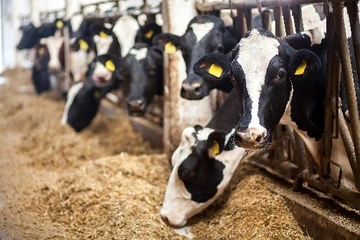Jump To:
Transmission:
Highly Pathogenic Avian Influenza, or avian flu or bird flu, is a disease caused by infection with avian Type A viruses.
This virus spreads naturally among wild aquatic birds via the fecal-oral route, but it can infect other birds, such as poultry and other animals. While HPAI can infect humans via direct contact (e.g., touching eyes, mouth, etc., with contaminated hands) and/or the respiratory route, it is rare. The transmission route is from a wild or domestic bird that may or may not have clinical signs to other birds and dairy cows nearby. Cow-to-cow spread is possible, but the specific transmission methods have not yet been determined. As of April 1, 2024, APHIS confirmed HPAI in dairy herds in Texas, New Mexico, Michigan, Idaho, and New Mexico, and the CDC confirmed HPAI in one dairy farm worker
General Information

Location: Idaho, Kansas, New Mexico, Michigan, Texas
For the most recent updates from USDA:
https://www.aphis.usda.gov/livestock-poultry-disease/avian/avian-influenza/hpai-detections/livestock
https://www.aphis.usda.gov/animal-emergencies/hpai
Name: Highly Pathogenic Avian Influenza (HPAI)
Type: Virus
Affected Livestock: Dairy Cattle
Clinical Signs in Dairy Cows: Clinical signs that have been seen include a drop in milk production, thickened or colostrum-like milk, appetite loss, manure inconsistencies, or a low-grade fever. Cows that are infected typically display symptoms for a period ranging from 7 to 10 days before experiencing a recovery. Approximately 10% of afflicted cows do not fully recuperate and fail to return to their previous levels of milk production, particularly those exhibiting the most severe symptoms. Moreover, those with severe symptoms can contract secondary infections like mastitis, pneumonia, or salmonellosis. Most infected have been multiparous, with signs occurring after early lactation.
Diagnosis: Producers working with their herd veterinarian and State Animal Health Officials and/or ALIRT veterinarians will collect a series of samples including nasal swabs and milk samples from all 4 quarters of symptomatic and asymptomatic dairy cows on a premises under investigation. These samples will be analyzed at both the National Animal Health Laboratory Network (NAHLN) lab in-state (Arizona Veterinary Diagnostic Lab) and National Veterinary Services Laboratory for confirmation of a non-negative.
Treatment: Following investigation by State Animal Health Officials, treatment shall be directed by the herd veterinarian and typically consists of supportive care (managing hydration and electrolytes, anti-inflammatory medication for fever, antibiotics if secondary bacterial pneumonia or mastitis are identified etc.) To prevent the virus from spreading and to protect human health, cows showing clinical signs should be isolated, and their milk must be diverted from the supply chain per Pasteurized Milk Ordinance requirements. Precautions for disposal of discarded milk should be taken, such as heat treatment or pasteurization. Cattle movement in and near the affected areas should stop immediately. Prevention is the best strategy and should focus on wild bird control on premises, limiting unnecessary animal or human movement on or off farm and quarantine of replacement animals prior to introduction to the herd.
Prognosis: Affected cows recover 7-10 days after showing first clinical signs. About 10% of affected cows do not recover fully in response to milk productivity.
Prevention: Biosecurity measures are the best tools for prevention. Avoid interstate movement of cattle when possible. Quarantine new cattle and avoid interacting with other cows. Sanitation of clothes, footwear and vehicles is recommended for those traveling in between several operations. Practice good hygiene when working with infected or non-infected cows, including frequent washing with virus-killing soaps, sanitizing shoes, and wearing appropriate masks. Controlling or avoiding wild bird populations although extremely difficult should be prioritized on farm. Equipment maintenance and appropriate milk parlor and claw sanitation and udder preparation should be of paramount importance.
Food Safety: *Dairies are required by law to send only milk from healthy cows to the processing plant for human consumption. Furthermore, pasteurization kills the virus, making milk safe to drink. Raw milk, however, carries risk for not only this virus but other pathogens as well so consumers assume their own risk with raw milk products. For more information on milk testing, see https://www.aphis.usda.gov/livestock-poultry-disease/avian/avian-influe….

